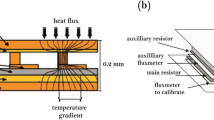Abstract
The optimum mold tool design for the consolidation of textile reinforced thermoplastic components requires the calculation of process times in development stage. A reduction of modeling effort can be achieved by homogenization of the thermal model parameters heat conductivity, specific heat capacity and density. On the example of braided hollow sections, consisting of glass-polypropylene-hybrid yarn, which includes reinforcement fibers and matrix material, the homogenization of these thermal model parameters is described. The comparison of simulated and measured temperature profiles of the consolidation process shows the applicability of this homogenization technique.










Similar content being viewed by others
References
Phillips R, Aküz DA, Manson JAE (1998) Prediction of consolidation of woven fibre-reinforced thermoplastics composites. Part I. Isothermal case. Compos Part A Appl Sci Manuf 29:395–402
Steggall-Murphy C, Simacek P, Advani SG, Yarlagadda S, Walsh S (2010) A model for thermoplastic melt impregnation of fiber bundles during consolidation of powder-impregnated continuous fiber composites. Compos Part A Appl Sci Manuf 41:93–100
Young WB (1995) Resin Flow analysis in the consolidation of multi-directional laminated composites. Polym Compos 16:250–257
Yan X (2006) Consolidation and cure simulations for laminated composites. J Compos Mater 40:1853–1869
Lee SE, Yoo JS, Kang JH, Kim CG (2009) Prediction of the thermal conductivities of four-axial non-woven composites. Compos Struct 89:262–269
Ismail MI (1988) Heat transfer through textile fabrics: mathematical model. Appl Math Model 12:434–440
Bhattacharjee D, Kothari VK (2009) Heat transfer through woven textiles. Int J Heat Mass Transf 52:2155–2160
Carson JK, Lovatt SJ, Tanner DJ, Cleland AC (2005) Thermal conductivity bounds for isotropic, porous materials. Int J Heat Mass Transf 48:2150–2158
McIvor SD, Darby MI, Wostenholm GH, Yates B, Banfield L, King R, Webb A (1990) Thermal conductivity measurements of some glassfibre- and carbonfibre-reinforced plastics. J Mater Sci 25:3127–3132
Bigaud D, Goyhénèche JM, Hamelin P (2001) A global-local non-linear modelling of effective thermal conductivity tensor of textile-reinforced composites. Compos Part A Appl Sci Manuf 32:1443–1453
Großmann K, Mühl A, Rehn S (2009) Variotherme Prozesse beim Konsolidieren textilverstärkter thermoplastischer Hohlprofile. ZWF Zeitschrift für wirtschaftlichen Fabrikbetrieb 104:242–249
Menges G, Haberstroh E, Michaeli W, Schmachtenberg E (2002) Werkstoffkunde Kunststoffe. Hanser, München
Moneke M (2001) Die Kristallisation von verstärkten Thermoplasten während der schnellen Abkühlung und unter Druck. Dissertation, Technische Universität Darmstadt
Zhang X, Hendro W, Fujii M, Tomimura T, Imaishi N (2002) Measurements of the thermal conductivity and thermal diffusivity of polymer melts with the short-hot-wire method. Int J Thermophys 23:1077–1090
Dos Santos WN (2007) Thermal properties of polymers by non-steady techniques. Polym Test 26:556–566
VDMA (1979) Kenndaten für die Verarbeitung thermoplastischer Kunststoffe, 1. Thermodynamik, Hanser München-Wien
AGY Holding Corp (2006) High strength glass fibers. Technical paper. http://www.agy.com/technical_info/graphics_PDFs/HighStrengthTechPaperEng.pdf. Accessed June 22, 2011
Kent EF (2009) Numerical analysis of laminar natural convection in isosceles triangular enclosures. Mech Res Commun 36:497–508
VDI-Gesellschaft (2006) VDI Wärmeatlas, 10th revised edition. Springer, Berlin
Acknowledgments
The described composite component is subject of BMBF—interdisciplinary project ToHoP, project number 02Pu2090 (Germany Federal Ministry of Education and Research). The homogenization techniques were partly developed in the subproject D4 of SFB 639 (German Research Foundation). The financial supports for these projects are greatly appreciated.
Author information
Authors and Affiliations
Corresponding author
Rights and permissions
About this article
Cite this article
Großmann, K., Kalisch, S., Mühl, A. et al. Thermal simulation of the consolidation process of textile-reinforced thermoplastic components using homogenized parameters. Prod. Eng. Res. Devel. 6, 251–257 (2012). https://doi.org/10.1007/s11740-012-0384-8
Received:
Accepted:
Published:
Issue Date:
DOI: https://doi.org/10.1007/s11740-012-0384-8




